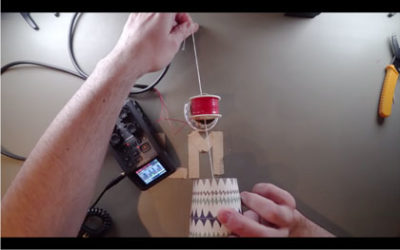Outside Scoop: How to Make a Paper Cup Microphone, Properly Apply Pitch Correction, And More
There were a variety of exciting music production articles and videos published this week. I’ve compiled the best content from around the web, making it easy to catch up on anything you may have missed. This Outside Scoop covers things like making a paper cup microphone on a budget, properly applying pitch correction, and achieving the classic sounds of the 80s using various plugins and mixing techniques.
Making a Paper Cup Microphone for Under $10
LeoMakes demonstrates how you can make your own paper cup microphone. It doesn’t sound what most engineers would consider “clean,” but it does seem to provide a nice lo-fi sound. You’ll need wire wrapping wire, a used up spool of solder or roll of toilet paper, wire cutters, a soldering iron, electricians tape, and some magnets. Watch the full video for the complete set of instructions on how to make a paper cup microphone.
15 Awesome Transient Designers
Slightly different than compressors, transient designers are input level independent, while compressors are input level dependent. They’re perfect for shaping the transients of dynamic recordings, such as the snare drum track in a Jazz arrangement. Philip Mantione of the Pro Audio Files rounds up 15 of the best transient designer options available.
10 Questions to Ask Before Buying New Gear
It’s difficult to determine what it’s worth spending your money on, and when the right time to spend money is. LANDR hands out some particularly useful gear purchasing advice, which can help you refrain from spending money on equipment that you don’t need.
How to Create Your Own Sample Instruments in Pro Tools
Mike Hillier of MusicTech walks us through how to make a multi-sampled instrument using the recordings of a 16-key Malian balafon. He uses UVI Falcon Pro which is included in both Pro Tools and Pro Tools Ultimate subscriptions and 1-Year Software Updates + Support Plans. The concepts powering this tutorial are transferable to other similar devices like Kontakt, although the exact means of application are somewhat different.
How to Apply Natural and Robotic Pitch Correction to Vocals
Learn how to use Celemony’s Melodyne and Antares’ Auto-Tune to apply both natural and robotic pitch correction to vocals. Black Ghost Audio covers pitch correction in detail, outlining some of the most fundamental parameters of both Melodyne and Auto-Tune. This guide is broken down into basic and advanced sections, making it accessible to everyone.
Why You Shouldn’t Be Afraid to Mod Your Gear
As Michael Hahn of LANDR states, “Modding is changing the circuitry of your gear to make it sound or perform better. That could mean swapping components, adding features or changing the circuit’s behavior.” Modding vintage synths to provide them with certain features found in modern equipment is quite a popular practice. Read the full article for a look at the Moog Slayer mod, Devilish TB-303 mod suite, and a closer look at circuit bending with alligator clips.
How to Make an EDM Track in Logic: Faustix ‘Bailamos’ Breakdown
Point Blank Music School has released a video featuring Faustix that takes a look at the Logic Pro X session for his track ‘Bailamos.’ He’s released songs with Diplo and Major Lazer and has put out music on Monstercat, Epic Records, and Atlantic. This video doesn’t actually explain how to write an EDM track from start to finish very well, but the conversation flows between various music production topics, with Faustix offering some valuable insight along the way.
13 Plugins for Getting an 80s Vibe (+ Production & Mix Tips)
Ian Vargo of the Pro Audio Files describes how you can achieve an 80s vibe in your music using 13 different plugins. This roundup is sprinkled with useful production and mix tips, making it much more valuable than your typical plugin list.
The Benefits of Using Subtractive EQ
Graham Cochrane of The Recording Revolution explains the basics of subtractive EQ and describes why it’s such a powerful mixing technique. Subtractive EQ allows you to buy yourself more headroom, provide clarity to your music, and help blend different track elements together. Watch the full video for a demonstration of this mixing technique.
Charles Hoffman is a Mixing and Mastering Engineer at Black Ghost Audio. After graduating from the University of Manitoba with an English degree, Charles completed his education at Icon Collective in Los Angeles, CA.
Please note: When you buy products through links on this page, we may earn an affiliate commission.








[…] http://sonicscoop.com/2019/03/02/outside-scoop-how-to-make-a-paper-cup-microphone-effectively-apply… Outside Scoop: How to Make a Paper Cup Microphone, Effectively Applying Pitch Correction, And More […]